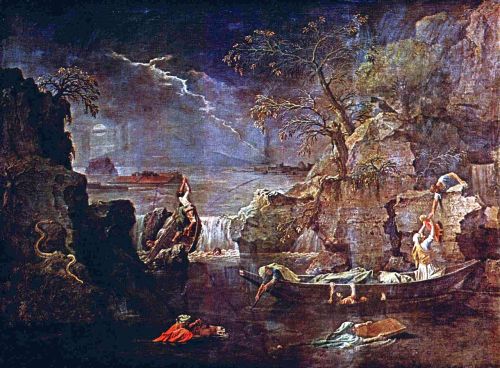Selz: No Connection Between the Biblical Patriarchs and the Babylonian Antediluvian Kings
“After an increasing wealth of Mesopotamian cuneiform tablets was excavated and translated in the middle of the nineteenth century, critical evaluation of the biblical traditions gained great momentum.
In 1872 George Smith delivered a paper to the Society of Biblical Archaeology in London, announcing the discovery of a Babylonian version of the biblical flood story, hereby renewing the interest in the extra-biblical traditions of Antiquity and eventually supporting the account of Berossos’ Babyloniaca.
A few years later, in 1876, Smith published his book The Chaldean Account of Genesis, in which he included translations of excerpts from fragments of Atrahasīs, a text which, together with the so-called “Creation Epic Enūma Elīsh,” soon became a corner stone for all comparisons between the biblical and Mesopotamian accounts of the “history” of primeval times.

Winter or Flood, by Nicolas Poussin (1594-1665 CE), painted between 1660 and 1664 CE. This oil on canvas work is in the permanent collection of the Louvre Museum, hanging in room 16, Richelieu, 2d floor.
Accession number INV 7306.
Courtesy of The Yorck Project: 10.000 Meisterwerke der Malerei. DVD-ROM, 2002. ISBN 3936122202. Distributed by DIRECTMEDIA Publishing GmbH.
The work of art depicted in this image and the reproduction thereof are in the public domain worldwide. The reproduction is part of a collection of reproductions compiled by The Yorck Project. The compilation copyright is held by Zenodot Verlagsgesellschaft mbH and licensed under the GNU Free Documentation License.
https://en.wikipedia.org/wiki/The_Four_Seasons_(Poussin)#The_Deluge
(See W.G. Lambert and A.R. Millard, Atrahasīs: The Babylonian Story of the Flood (London: Oxford University Press, 1969), p. 3.)
(The comparison of the Mesopotamian flood story with its Noah-related figure of Ziusudra/Utnapishtim and the Babylonian Epic of Creation in conjunction with Berossos’ account of Babylonian History fostered many hypotheses and any originality of the biblical stories became disputed.
In 1902 H. Zimmern published his influential article “Urkönige und Uroffenbarung,” in E. Schrader, Die Keilinschriften und das Alte Testament (ed. H. Zimmern and H. Winckler; 3rd ed.; 2 vols.; Berlin: Reuther & Reichard, 1902-1903), 2:530-543, in which he attempted to parallel the names of the biblical primeval patriarchs and similar figures from extra-biblical traditions.
Great influence gained F. Delitzsch who with his lectures on “Babel und Bibel” (1902-1905) provoked the so-called “Babel-Bibel Streit”; see F. Delitzsch, Babel und Bibel (Leipzig: Hinrichs, 1921).
Later he took an even more open hostile stand against the traditional theologians in his work Die große Täuschung: Kritische Betrachtungen zu den alttestamentlichen Berichten über Israels Eindringen in Kanaan, die Gottesoffenbarung vom Sinai und die Wirksamkeit der Propheten (2 vols.; Stuttgart: Deutsche Verlagsanstalt, 1920-1921.)

Among the extant exemplars of the Sumerian King List, the Weld-Blundell prism in the Ashmolean Museum cuneiform collection represents the most extensive version as well as the most complete copy of the King List.
Listing rulers from the antediluvian dynasties to Suen-magir, the fourteenth ruler of the Isin dynasty (ca. 1763–1753 B.C.), the prism has four sides with two columns on each side.
The prism is perforated, and it originally stood on a wooden spindle going through its centre so that it could be rotated and read on all four sides.
http://cdli.ox.ac.uk/wiki/doku.php?id=the_sumerian_king_list_sklid=the_sumerian_king_list_skl
To cut a long story short, when S. Langdon published the Weld-Blundell (WB) copy of the Sumerian King List in 1923, a thorough revision of earlier opinions became necessary.
(A. Deimel, “Die babylonische und biblische Überlieferung bezüglich der vorsintflutlichen Urväter,” Orientalia (Rome) 17 (1925): pp. 33-47; cf. further H. Zimmern, “Die altbabylonischen vor-(und nach-) sintflutlichen Könige nach neuen Quellen,” ZDMG 78 (1924): pp. 19-35.
W.G. Lambert, “A New Fragment from a List of Antediluvian Kings and Marduk’s Chariot,” in Symbolae Biblicae et Mesopotamicae: Francisco Mario Theodoro de Liagre Böhl dedicatae (ed. M.A. Beek et al.; Studia Francisci Scholten memoriae dicata 4; Leiden, Brill, 1973), pp. 271-80, 271, pointed out that the connection of the patriarchs to the tradition of the Sumerian King List was first established by Josephus who again depended on Berossos.)
It became clear, in particular, that the names of (most) of Berossos’ early Babylonian rulers were of Sumerian origin. Zimmern himself revised his earlier theories and Pater Anton Deimel even disputed any connection of the cuneiform tradition to the biblical patriarchs.”
(A. Deimel, “Urväter,” p. 43 states: “(Es) dürfte besser ehrlich einzugestehen sein, dass bis jetzt kein Zusammenhang irgendwelcher Art zwischen der babylonischen und der biblischen Überlieferung bezüglich der vorsintflutlichen Urväter erwiesen ist.”
(“It is likely better to honestly admit that so far no connection whatsoever between the Babylonian and the biblical tradition is established with respect to the antediluvian patriarchs.”)
Gebhard J. Selz, “Of Heroes and Sages–Considerations of the Early Mesopotamian Background of Some Enochic Traditions,” in Armin Lange, et al, The Dead Sea Scrolls in Context, v. 2, Brill, 2011, pp. 789-90.
